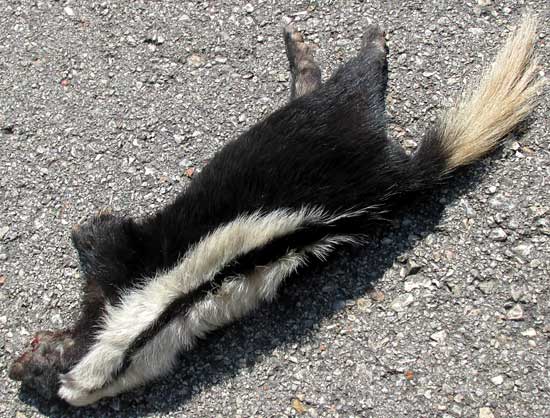Excerpts from Jim Conrad's
Naturalist Newsletter
from the May 14, 2017 Newsletter issued from Rancho Regenesis in the woods ±4kms west of Ek Balam Ruins; elevation ~40m (~130 ft), N20.876°, W88.170°; north-central Yucatán, MÉXICO
STRIPED HOG-NOSED SKUNK
Last Sunday morning on the north/south highway between Valladolid and Río Lagartos, about 3kms north of Temozón where most Sundays I visit the frutaría, a black and white skunk appeared as roadkill in the middle of the road. I don't like dealing with roadkill, but sometimes roadkill affords the only opportunity to see animals that are rare or nocturnal. Even before I reached the corpse, I could smell the strong skunky odor. Below, you can see the dead unfortunate lying on the pavement as I found him

In a list of medium-size and larger mammals of the Yucatan, three skunk species are listed. I've had several encounters with the Spotted Skunk, one funny experience documented at www.backyardnature.net/yucatan/spotsknk.htm
Spotted Skunks are much smaller than our roadkill, however, so this was something new for me. My memory seemed to be that the two remaining Yucatan species were the Striped and Hognosed Skunks. Our picture shows a skunk with stripes and the nose doesn't look much like a hog's, so I assumed we had a Striped Skunk.
However, comparing pictures on the Internet quickly proved me wrong: This is the Striped Hog-nosed Skunk, CONEPATUS SEMISTRIATUS, a strictly neotropical skunk distributed from southern Mexico to northern Peru and eastern Brazil. It is nocturnal and solitary, and studies of its scat remains indicate that it feeds mainly on insects, lizards and birds, with termites being favored insects. Seeds, nuts and fruits also are eaten.
The Striped Skunk, Mephitis macroura, I had remembered as a citizen of the Yucatan apparently occurs only in the extreme southern part of the Peninsula and probably doesn't occur here in the north, though its distribution seems to be expanding.
The Striped Hog-nosed Skunk's nosepad isn't shaped like a hog's, but it's thicker and blunter than those of other skunk species, which probably helps when rooting in the soil for invertebrates. The literature describes its claws as particularly long for a skunk, also useful for grubbing in the soil.
The AnimalDiversity.Org web page for the species says that its breeding season is unknown, that the parents' manner of caring for its offspring is undocumented, and that there are no reports on how long members of the species live.
With such limited information available I'm encouraged to think that even our mention of its presence as roadkill in north-central Yucatan may be welcome to some future researcher considering the species.